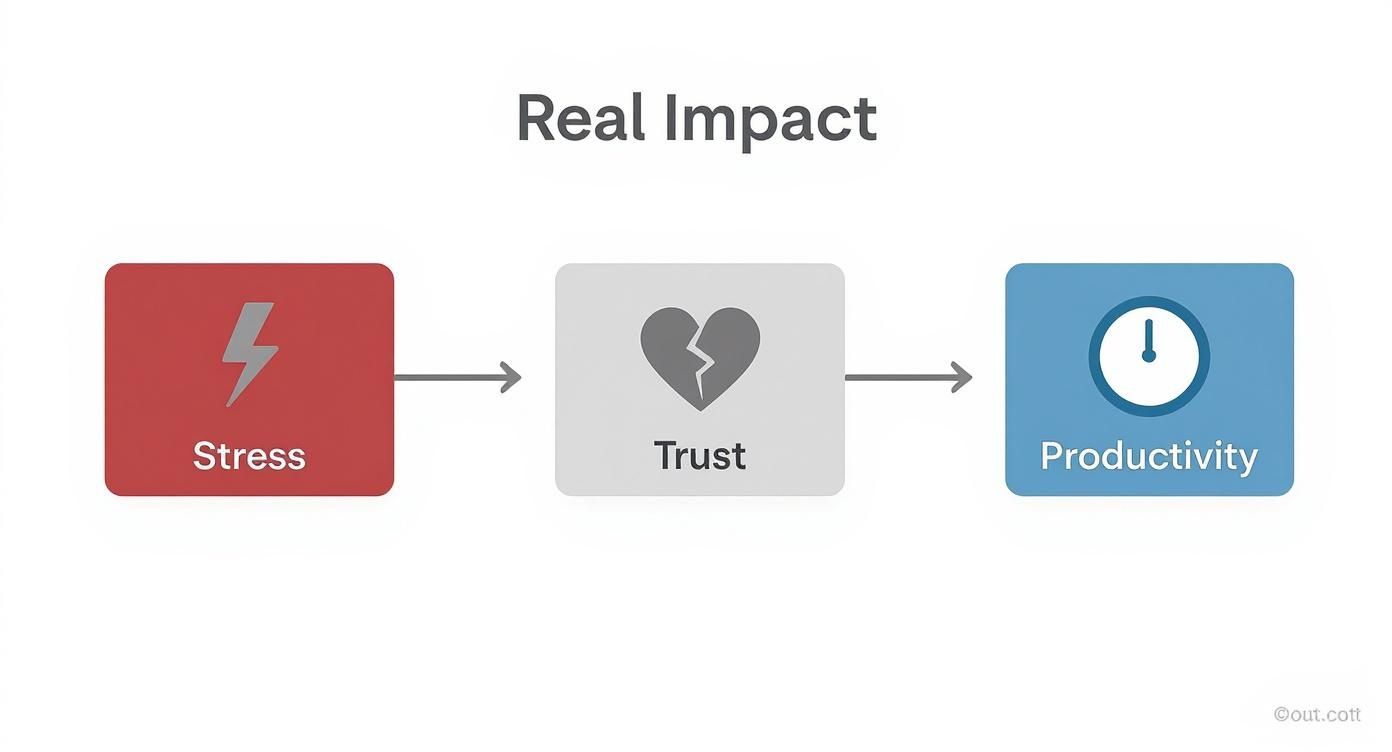Fixing Breakdown in Communication in Relationships
- Therapy-with-Ben
- 3 days ago
- 10 min read
Posted Under Author: Therapy-with-Ben
A communication breakdown feels like you’re talking full tilt, but landing on deaf ears. It’s the space between intention and understanding, where your words drift off course. Spotting that gap is the very first step to closing it and finding your way back to genuine dialogue.
What A Communication Breakdown Actually Looks Like

Have you ever walked away from a chat with your partner, colleague or friend wondering if you both spoke different languages? That awkward, heavy silence that follows is often the hallmark of a communication breakdown—not always a shouting match, but a widening gap you can almost feel.
This derailment isn’t usually about laziness; it springs from crossed wires—unspoken assumptions, clashing viewpoints or half-listened remarks. One person might be reaching out for comfort, while the other hears nothing but critique.
The Subtle Signs Of A Failing Dialogue
A full-blown collapse rarely happens overnight. It creeps in through tiny cracks you barely notice until they’ve turned into gaping holes.
Common early warnings include:
Frequent Misunderstandings: You catch yourself saying, “That’s not what I meant,” again and again.
Assuming The Worst: Instead of checking in, you leap to negative conclusions about their tone or choice of words.
Feeling Unheard: The conversation ends, and you’re left feeling more isolated than before you started.
“A breakdown isn’t just a failure to speak; it’s a failure to be understood. The single biggest problem in communication is the illusion that it has taken place.”
Left unchecked, these small missteps build up until even the simplest chat feels like a battleground. Spotting and naming them early sets the scene for the practical fixes we’ll explore next.
Understanding the Root Causes of a Communication Breakdown
A communication breakdown rarely just pops up out of nowhere. It’s almost always a symptom of something deeper going on under the surface. Figuring out these root causes is a bit like finding the right key for a locked door—it lets you solve the actual problem instead of just rattling the handle in frustration.
These triggers can be intensely personal, often stemming from our own anxieties or past experiences. They can also be relational, tangled up in the unique dynamic between two people. For instance, unspoken expectations or a history of arguments you’ve never quite resolved can turn every conversation into a minefield. Your personal communication style, which is heavily shaped by your upbringing, also plays a massive part. To get a better sense of how those early relationships influence your patterns today, it’s worth exploring what attachment theory is and how it shapes you.
To help you start pinpointing what might be going on, I've put together a table summarising the four main categories of causes. It includes some common examples and the signs you might notice, which can help you connect the dots.
Common Triggers for a Communication Breakdown
Cause Category | Key Examples | Common Symptoms |
|---|---|---|
Individual Triggers | Stress, anxiety, low self-esteem, neurodiversity (e.g., ADHD, autism), past trauma. | Over-explaining, being overly apologetic, misinterpreting tone, difficulty articulating thoughts. |
Relational Dynamics | Unresolved conflicts, power imbalances, differing communication styles, unspoken expectations. | Feeling unheard or defensive, frequent arguments over small things, emotional distance, walking on eggshells. |
Environmental Factors | Noisy or distracting surroundings, lack of privacy, high-pressure situations (e.g., work deadlines). | Inability to focus, constant interruptions, feeling rushed or stressed during conversations. |
Technical & Digital Issues | Poor internet connection, messages lost in translation (no tone/body language), software glitches. | Misunderstandings via text/email, dropped calls, frustration with technology, delayed responses. |
Looking at these different areas can give you clues about where the real friction lies. It's often a combination of factors, not just one single thing.
Individual and Relational Triggers
On a personal level, things like stress, low self-esteem, or even neurodiversity can fundamentally change how we send and receive messages. When we feel anxious, for example, we might struggle to say what we mean or automatically assume someone else's intentions are negative.
This is a huge issue in the workplace. A recent UK survey found that a staggering 84% of working people worry about being judged by colleagues for how they communicate. Habits like constantly over-explaining or apologising for everything are often signs of this anxiety bubbling away, and they directly lead to misunderstandings.
A breakdown often begins internally. When we are not clear or confident within ourselves, it is almost impossible to be clear and confident with others.
Environmental and External Pressures
The space we communicate in matters just as much as the words we use. A noisy, chaotic room makes it nearly impossible to listen properly. And in our increasingly digital world, the very technology we depend on can become a source of failure.
Think about how many important conversations now happen over text or email, completely stripped of the vital context we get from someone’s tone of voice and body language. For those of us relying on calls over the internet, technical glitches can silently sabotage a conversation. In fact, understanding how specific network settings can disrupt VoIP calls is crucial for anyone trying to fix these modern-day communication hurdles.
Ultimately, identifying these varied causes—whether they’re personal, relational, or environmental—is the first, most practical step toward rebuilding clearer and more meaningful connections.
The Real Impact of a Communication Breakdown
When communication starts to fail, the effects run much deeper than just the words that were (or weren't) said. The fallout ripples through our lives, hitting our mental wellbeing, shaking the foundations of our relationships, and even getting in the way of our work. It’s like a quiet emotional debt that just gets heavier the longer it’s left unpaid.
On a personal level, it’s profoundly isolating to feel constantly misunderstood or just plain ignored. It can spark a real sense of anxiety, making you second-guess every word before it leaves your mouth. Living in that state of high alert is exhausting and often sends stress levels through the roof. You end up feeling perpetually on edge, even in your own home.
The Erosion of Trust and Connection
Trust is the very bedrock of any healthy relationship, and a communication breakdown is one of the quickest ways to see it crumble. Every argument that goes unresolved, every feeling that gets dismissed, is another small crack in that foundation. Over time, this creates an emotional chasm that can feel impossible to cross.
You might start to notice it in subtle ways:
Holding back your true feelings because you're terrified of starting another fight.
A profound sense of loneliness, even when you’re in the same room as the other person.
A simmering resentment that starts to colour all your daily interactions.
This distance doesn't just appear out of nowhere. It's built one misunderstanding at a time, leaving both people feeling disconnected and alone.
The Tangible Costs in Our Daily Lives
The consequences aren't just emotional; they have a very real, measurable impact on our day-to-day, especially professionally. In the workplace, a simple miscommunication can spiral into missed deadlines, frustrated teams, and a toxic environment where nobody feels safe enough to speak their mind. For businesses, this has a significant impact.
Studies looking at UK workplaces have directly linked miscommunication to a staggering 41% decrease in productivity. Not only that, but it also accounts for 35% lower job satisfaction and a 31% drop in professional confidence, to say nothing of the financial cost of wasted time and delayed projects. You can discover more insights about the effects of miscommunication in the workplace on pumble.com.
Ultimately, whether it's at home or in the office, the cost is the same. A breakdown in communication chips away at our happiness, our security, and our sense of belonging. Recognising these deep-seated impacts is the first step toward understanding just how urgent it is to start mending these vital connections.
Practical Strategies To Repair Communication
Recognising you’ve hit a communication snag is only half the battle. The real work starts when you roll up your sleeves and start mending those conversational cracks. Fortunately, you don’t need a degree in psychology—just a handful of straightforward, proven techniques to reignite understanding and rebuild trust.
That shift from pointing fingers to asking questions is crucial. When you drop the urge to “win” an argument and instead get curious about the other person’s experience, you open a door. Suddenly, a tense exchange becomes an invitation to reconnect.
This flow chart shows how a breakdown in communication directly leads to increased stress, eroded trust, and ultimately, reduced productivity.

The chain reaction is clear: friction in words spills over into emotions, relationships and even output at work.
Adopting Foundational Techniques For Repair
When you’re ready to rebuild, these two tools are non-negotiable:
Active Listening • Put away your phone, lean in and mirror back what you hear. • Reflect feelings (“It seems you felt let down when…”) rather than just summarising facts.
‘I’ Statements • Speak from your own experience: “I feel overwhelmed when…” instead of “You always…” • This small language tweak can dramatically reduce defensiveness and open up more honest dialogue.
For more hands-on tips, check out our guide on how to communicate better in relationships.
Structuring Difficult Conversations
High emotions demand a little scaffolding. Start by agreeing on a time and place that feels private and calm. Borrow a page from professional meetings—learning how to write an effective meeting agenda can help both of you stay on track.
Agree on a “pause word.” The moment either person feels overwhelmed, use this cue to take a 20-minute break. This isn’t avoidance. It’s about giving your brain a breather so you can return with fresh perspective.
Set a few ground rules too:
No raised voices
No personal attacks
Stick to one topic at a time
These simple boundaries create emotional safety, making it easier to keep things constructive.
Seeing Things From Another Perspective
Empathy isn’t just a buzzword—it’s a bridge. When you genuinely ask, “What’s it like to be in your shoes right now?” you’re gathering clues about their feelings, fears and triggers.
In high-pressure settings—like parts of the NHS—the fallout from dismissive, rushed conversations can be catastrophic. You can find more detail in NHS England’s full report on patient safety and communication: NHS England’s full report on patient safety and communication. These case studies drive home just how vital psychological safety is for honest, life-saving dialogue.
To pull these ideas together, here’s a quick comparison:
A Comparison of Communication Repair Techniques
Technique | Implementation Steps | Expected Outcome |
|---|---|---|
Active Listening | 1. Remove distractions2. Reflect emotions3. Ask clarifying questions | Deeper understanding and validation of feelings |
‘I’ Statements | 1. Identify your feeling2. Name the trigger3. Express want or need | Lower defensiveness and more open expression |
Agreed Pause Word | 1. Choose a neutral word2. Call the pause when needed3. Reconvene after break | Emotional regulation and calmer, focused discussion |
Empathy Mapping | 1. List their possible thoughts and feelings2. Note relevant experiences3. Discuss impressions | Stronger sense of connection and reduced blame |
Putting a few of these strategies into practice can feel like peeling back layers of tension, bit by bit. Ultimately, effective repair comes down to curiosity, kindness and a plan to keep conversations both safe and centred.
When You Might Need Professional Support
While tackling communication issues on your own is incredibly powerful, some problems run too deep to be solved by good intentions alone. It's a sign of strength, not weakness, to realise when you've hit a wall and could use a helping hand. Deciding to get professional support is a positive, proactive step toward lasting change.
Key Signs It Is Time to Seek Help
Think about reaching out to a therapist or counsellor if you’re consistently noticing:
Recurring Conflicts: You feel like you're stuck on a hamster wheel, having the same arguments over and over with no real resolution.
Emotional Burnout: Instead of feeling heard, conversations leave you feeling drained, hopeless, or constantly on edge.
Deep Resentment: Old hurts and unresolved issues have piled up, making it feel almost impossible to trust or connect with each other.
Total Avoidance: It’s become easier to say nothing at all than to risk another painful conversation, creating a silent and growing distance between you.
A communication breakdown that doesn’t improve despite your best efforts is often a sign of deeper, underlying patterns. A therapist provides a neutral, safe space to untangle these knots without blame or judgment.
If any of this sounds familiar, it doesn't mean you've failed. It just means the problem has become too tangled for a DIY approach. An initial therapy session can bring so much clarity about what's really going on beneath the surface. It’s a chance to explore these ingrained issues in a structured way, learn new ways of relating, and finally break the cycle for good.
Posted Under Author: Therapy-with-Ben
How Therapy with Ben Can Help
Trying to fix a communication breakdown on your own can feel incredibly isolating and, frankly, overwhelming. I get it. That's why at Therapy with Ben, I offer a dedicated, supportive space where we can work together to untangle those knots of misunderstanding and find your way back to connection. The goal isn't just to talk, but to use structured, evidence-based tools that are right for your specific situation.
My entire approach centres on creating a safe, non-judgemental environment. It’s a space where you can honestly explore your communication patterns without any fear of getting it "wrong." Together, we'll set clear, achievable goals, focusing on practical skills that build healthier, more authentic dialogue. Whether we meet in person or online, every session is about building your confidence.
Unique Therapeutic Approaches
To help you on this journey, I offer a couple of distinct therapeutic settings, because one size definitely doesn't fit all:
Walk-and-Talk Therapy: There's something powerful about getting outside and moving. Engaging in gentle movement in a natural environment can help lower inhibitions, making it that much easier to open up and explore difficult feelings. It’s a great way to shift your mindset.
Online and Face-to-Face Sessions: For those who prefer a more traditional setting or simply need more flexibility, I also provide confidential online and in-person options.
These different approaches ensure you can find a way to work through your challenges that feels comfortable and effective for you. My aim is to give you the tools not just to repair what’s broken now, but to build more resilient, trusting connections for the years to come.

If you'd like to learn more about how we could work together, feel free to explore the different therapy services with Ben in Cheltenham.
Posted Under Author: Therapy-with-Ben
Frequently Asked Questions
Working through a communication breakdown often feels daunting. Yet with a handful of practical steps, you can begin to rebuild trust and understanding again.
What If Only One Person Is Trying To Fix The Communication?
It’s tough when only one person is making the effort. That said, one steady voice can change the entire dynamic over time.
Consistent, calm communication can open doors that once felt firmly closed.
Focus on what you can control:
Speak from your own experience using ‘I’ statements.
Listen fully, without jumping to judgement.
Maintain clear personal boundaries and remind yourself why they matter.
Over weeks or months, this approach often encourages the other person to engage more thoughtfully.
How Can I Stop Arguments From Escalating?
Arguments escalate when emotions run unchecked. First, agree on a signal—a word or gesture—that means “Pause, please.”
Next, step away together for at least 20 minutes. Doing so:
Prevents you from saying things you’ll regret
Gives your nervous systems time to settle
Creates space for a more constructive conversation once you reconvene
In practice, a short break can transform a heated debate into a calm dialogue.
What Daily Habits Can Improve Our Communication?
Small habits add up. Try weaving these rituals into your everyday routine:
A brief morning or evening check-in: share one high and one low of the day
Phone-free zones during mealtimes or walks
A quick “thank you” or genuine compliment when you notice something kind
Over time, these little gestures build goodwill. They lay the groundwork for tackling trickier topics with greater ease.
If you feel trapped in repetitive patterns despite these efforts, professional support can offer new perspective. At Therapy with Ben, I create a safe, non-judgmental space to explore these challenges and develop healthier communication habits together. To learn more or book an initial consultation, please visit Therapy with Ben.
Posted Under Author: Therapy-with-Ben

.jpg)



Comments